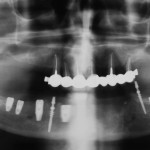
As the number of dental implants being placed increases it seems inevitable that the numbers affected by peri-implantitis will also increase. Peri-implantitis is inflammation of the peri-implant tissues accompanied with changes in the level of crestal bone and with the presence of bleeding on probing and/or suppuration, with or without concomitant deepening of peri-implant pockets. Rates of peri-implantitis have been reported as being between 2 – 47% . The aim of this review was to evaluate the effectiveness of reconstructive procedures for treating peri-implantitis.
The Medline, Pubmed, Embase and Dentistry and Oral Sciences Source databases were searched. Reference list of articles were also searched. Two reviewers selected articles and risk of bias assessment was carried out. The primary outcome was radiographic defect fill (RDF) but probing depth (PD), clinical attachment level (CAL), and bleeding on probing (BOP) were also considered.
Studies that compared at least 1 clinical and radiographic parameter between reconstructive therapies and other surgical modalities, such as resective or open flap debridement surgeries, for treating peri-implantitis, with a minimum sample size of 10 implants and at least 12 months of observation were sought.
- Twelve studies were included, 3 randomized controlled trials (RCTs), 3 quasi-experimental studies and 6 case series.
- Only 1 RCT compared the effectiveness of the reconstructive procedure over the non-reconstructive procedure. The other 2 compared different reconstructive procedures.
- Overall 390 implants were followed up between 12-63 months.
- 4 meta-analysis were presented of weighted mean differences for
- RDF was 2.17 mm (95% confidence interval [CI]: 1.46-2.87 mm),
- PD reduction was 2.97 mm (95% CI: 2.38- 3.56 mm),
- CAL gain was 1.65 mm (95% CI: 1.17-2.13 mm), and
- BOP reduction was 45.8% (95% CI: 38.5%-53.3%)
The authors concluded
Currently, there is a lack of evidence for supporting additional benefit of reconstructive procedures to the other treatment modalities for managing peri-implantitis.
Comment
The 2012 Cochrane Review by Espositio et al looked at all treatments for peri-implantitis. They considered any non-surgical or surgical procedure including the use of local or systemic therapeutic agents as well as any other interventions aimed at the recovery of peri-implant oral health. Nine RCTs were included in their review and they concluded:-
There is no reliable evidence suggesting which could be the most effective interventions for treating peri-implantitis. This is not to say that currently used interventions are not effective.
This current review focused on regenerative approaches, although, only 1 RCT actually compared these with non-regenerative approaches and there were only 16 patients in the intervention arm. The majority of the studies contributing to the meta-analysis presented were from case series with relatively small sample sizes as the authors note in their discussion. There is also much heterogeneity in the implant systems and approaches.
From the findings of the Cochrane review and this current review it is apparent that evidence is lacking for the best approaches to treat peri-implantitis With increase numbers of implants there is a need for high quality studies of appropriate size to begin to answer the question.
Links
Khoshkam V, Chan H, Lin G, Maceachern MP, Monje A, Suarez F, Giannobile WV, Wang H. Reconstructive Procedures for Treating Peri-implantitis: A Systematic Review. J Dent Res. 2013 Oct 24. [Epub ahead of print] PubMed PMID: 24158331.
Esposito M, Grusovin MG, Worthington HV. Interventions for replacing missing teeth: treatment of peri-implantitis. Cochrane Database of Systematic Reviews 2012, Issue 1. Art. No.: CD004970. DOI: 10.1002/14651858.CD004970.pub5.
